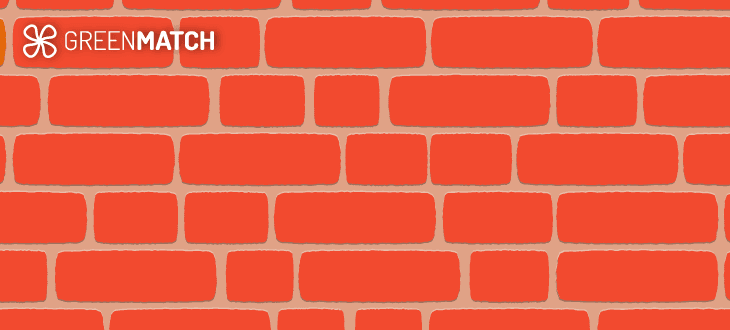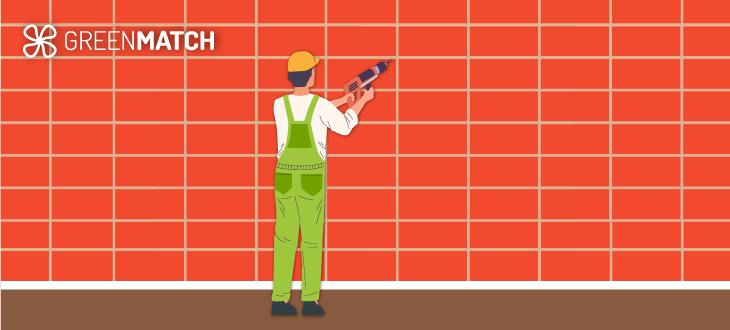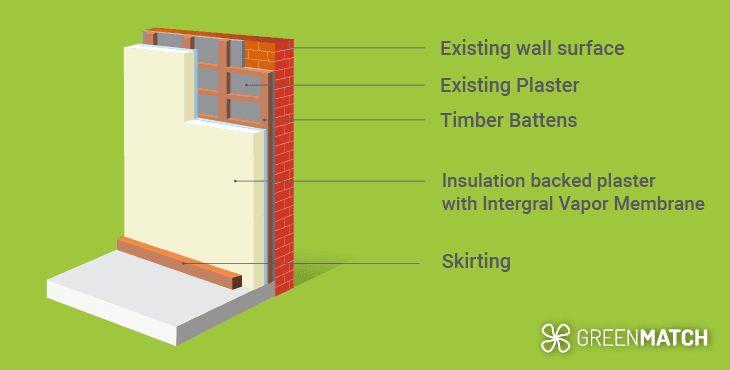Answer these simple questions and we will find you the BEST prices
Which type of solar quotes do you need?
It only takes 30 seconds
100% free with no obligation

Get Free quotes from insulation specialists near you

Save money by comparing quotes and choosing the most competitive offer

The service is 100% free and with no obligation
- GreenMatch
- Insulation
- Wall Insulation
- Internal Wall Insulation
Your Ultimate Guide to Internal Wall Insulation UK (2025)


- Internal wall insulation is cost-effective and can be up to 50% cheaper than external wall insulation.
- The typical cost of internal insulation ranges from £40 to £50 per square metre.
- Properly installed internal wall insulation can last up to 25 years, providing long-term energy savings and increasing the value of your home by up to 14%.
- Internal wall insulation is an effective way for homes located in protected or conservation sites to improve energy efficiency without altering the house's external appearance.
Poorly insulated walls are a significant source of heat loss, with up to 35% of your home’s warmth escaping through uninsulated surfaces. In the UK, where more than 21 million homes suffer from inadequate or non-existent insulation, this issue not only drives energy bills to all-time highs but also plays a major role in the country's carbon emissions—domestic energy use alone accounts for a staggering 27% of the UK’s total carbon footprint.
For homeowners with solid walls or those living in properties where altering the exterior is not an option, such as historic homes, internal wall insulation presents a highly effective and practical solution. This approach is not only one of the most efficient ways to retain heat but also one of the most cost-effective. By choosing internal wall insulation, you could save between £140 and £700 annually on your energy bills while reducing your carbon emissions by 410 to 2,100 kg of CO2 each year.
In this ultimate guide, we will explore everything you need to know about internal wall insulation—from the different types available and methods of installation to costs involved—so you can make an informed decision about whether this is the best choice for your home.
If you're ready to boost your home's energy efficiency and save on energy bills, let GreenMatch connect you with top-rated internal insulation specialists. Simply fill out our quick form to receive up to four free quotes from expert installers, ensuring you get the best advice and deals with no hidden costs. Click below to get started!
- Describe your needs
- Get free quotes
- Choose the best offer
It only takes 30 seconds



What is internal wall insulation?

Insulating your internal walls involves adding a layer of insulation material to the inside of your home's existing walls. Attach rigid insulation boards directly to the wall or build a stud wall filled with insulation for effectiveness. Once insulated, apply smooth plasterboard for a finished surface, ready for painting or wallpapering.
The method includes several vital layers:
- Existing wall surface: The original interior wall is made of brick, stone, or other materials.
- Vapour control layer: A layer that prevents moisture build-up, reducing the risk of condensation and dampness.
- Insulation layer: The main insulating material that acts as a thermal barrier, reducing heat loss.
- Plasterboard or internal finish: The final layer, typically plasterboard, provides a smooth, decorative surface.
Insulation for walls is especially effective for homes with solid walls that do not have cavities for insulation or in cases where cavity wall insulation is not possible. It is a cost-effective solution, often more affordable than external wall insulation, which can be up to 50% more expensive. Additionally, internal insulation is ideal for homes where the exterior cannot be altered, such as historic or protected buildings.
Only external walls separating your living space from the outside typically need internal insulation, not all walls. Internal walls usually don’t require insulation unless soundproofing or temperature control between rooms is necessary.
How do you know if your home has solid walls?
Determining whether your home has solid walls is important when considering internal wall insulation options. Here are a few ways to identify if your home has solid walls:

Age of your property: Homes constructed before the 1920s in the UK likely have solid walls, as cavity wall construction was uncommon.

Brick pattern: Check your exterior brick pattern to identify solid walls. Solid walls show alternating long sides (stretchers) and short ends (headers) of bricks in sequence.

Wall thickness: Solid walls tend to be thinner than cavity walls. You can measure the thickness by checking at a window or door. Solid walls are typically around 260mm or less.

Drilling: Insulation specialists might use a small drill to inspect the wall's construction. This method is more invasive but can confirm whether the wall is solid or has a cavity.
Knowing if your home has solid walls is important because it affects the insulation options available. Cavity walls are designed for insulation within the cavity, adding internal insulation may not improve efficiency and could be costly. It can also lead to moisture problems and structural issues. Identifying your wall type will help you choose the best insulation solution for improving your home's energy efficiency.
Best insulation for interior walls

When insulating interior walls, choosing the best wall insulation is crucial. When choosing insulation, consider factors such as wall type, budget, and specific requirements. Prioritise materials with a high R-value that are also moisture-resistant and fire-resistant. A variety of materials are available for internal wall insulation, including:
- Rigid foam boards
- Fibreglass
- Cellulose
- Mineral wool
- Cork boards
- Sheep wool
You can choose your material based on personal preference, but we’ve highlighted some of the best and most popular internal insulation materials in the UK.
Rigid foam boards
Rigid foam boards, such as polyisocyanurate (PIR), extruded polystyrene (XPS), and expanded polystyrene (EPS) boards. They are highly effective insulation options due to their high thermal resistance (R-value) and ease of installation. These boards are particularly effective at reducing heat loss, making them ideal for homes with solid walls.
Additionally, they offer good moisture resistance, making them suitable for areas prone to dampness. These boards can be applied directly to your internal walls, providing excellent insulation with minimal thickness. They are an ideal solution for those looking to maximise interior space while enhancing energy efficiency.
Fibreglass
People commonly use this material for internal wall insulation because it effectively traps heat and is affordable. Manufacturers treat it with a fire-retardant substance, enabling it to withstand temperatures up to 540 degrees Celsius, ensuring safety in case of fire or high heat.
However, it does not provide an airtight seal, which can lead to moisture issues. The material can absorb water, reducing its ability to block heat transfer and lowering its R-value. This can create conditions conducive to mould and mildew growth.
Despite these drawbacks, this insulation is an excellent choice for budget-conscious projects or where ease of installation is a priority. It is particularly well-suited for insulating stud walls.
Cellulose
Cellulose insulation is an eco-friendly, effective option for internal walls, made from recycled paper treated with fire-retardant chemicals.
Though moisture-resistant, cellulose can sag in damp conditions, so proper ventilation is crucial to prevent long-term issues. We do not recommend cellulose for homes with stone walls, as moisture management poses a significant concern in those cases.
Despite these drawbacks, cellulose remains an excellent choice for those seeking a sustainable insulation material with a good R-value. It provides an effective airtight seal when properly installed and is one of the most cost-effective sustainable insulation options available.
Spray foam
This type of internal wall insulation comes in two forms: open-cell and closed-cell spray foam. When applied, spray foam expands to fill gaps and cracks, creating a highly effective thermal barrier. Closed-cell foam provides excellent insulation and moisture resistance, while open-cell foam excels at soundproofing.
However, spray foam insulation is among the more expensive insulation options. It requires careful handling, as the chemicals can harm the skin and respiratory system. This necessitates protective gear during installation. Despite these drawbacks, spray foam is an excellent choice for insulating areas with complex shapes or hard-to-reach spaces where traditional insulation may fall short. It is also ideal for adding structural strength to walls.
How to insulate internal walls
You can install internal wall insulation using various methods, depending on the insulation material, your home's specific needs, and your budget. Before selecting the most suitable method for your home, it is essential to follow these preparatory steps:
- Assess the condition of your walls: Inspect your walls for any signs of dampness or damage. It's crucial to repair any issues before installing insulation to ensure its effectiveness and prevent future problems.
- Understand the dew point: The dew point is the temperature at which air becomes saturated with moisture, leading to condensation. If the temperature of your internal walls drops to or below the dew point, moisture can condense on the surface. Properly managing the dew point within the wall structure is essential. This may involve adding a vapour barrier to prevent condensation in areas that could cause long-term damage.
- Remove fixtures: Remove fixtures like electrical outlets, radiators, skirting boards, curtain rails, and shelves. Turn off power and drain radiators, and carefully unscrew or pry off items. Label and store all hardware for easy reinstallation after insulation. Repair any wall damage before proceeding with insulation and plasterboard.
- Address potential thermal bridges: Identify areas prone to thermal bridging, such as window and door reveals, floor voids, beams, joists, and pipes. These areas can easily allow heat to escape. Properly insulate them to maintain the continuity of the thermal envelope before starting the main insulation installation.
- Prepare the wall surface: Remove any old plaster, wallpaper, or paint to create a smooth, clean surface to ensure proper insulation adhesion and effective performance.
Once you're familiar with the necessary steps to prepare for internal insulation, you can select your preferred installation method. Here's how to insulate internal walls:
Stud wall insulation

Stud wall insulation involves building a 100 mm thick secondary wall, with a 40 mm cavity between it and the existing wall. Though reducing floor space, it supports thicker insulation, offering excellent thermal performance and space for wiring or plumbing.
After constructing the stud wall, insulation is installed between the studs. The insulation must fit snugly, as gaps cause thermal bridging and reduce overall effectiveness. After installation, a vapour barrier prevents condensation and moisture issues within the wall. The final step involves fixing plasterboard panels over the stud wall framework to create a smooth, finished surface.
Constructing a stud wall requires more labour and materials, making it pricier but ideal for older or damp-prone walls. While not always more efficient, it accommodates thicker insulation and addresses problematic walls, making it valuable in certain situations.
Direct wall insulation

Direct wall insulation simplifies internal insulation by applying materials directly to the interior surface of existing walls. This method commonly uses rigid foam boards, which are typically glued to the wall's surface.
After installing the insulation, carefully seal the joints between the boards to prevent air leakage. Next, cover the insulation with a vapour barrier and finish with plasterboard, creating a smooth, durable surface.
This method is ideal for homes with flat walls and few to no damp issues. It is cost-effective, less invasive, and relatively easy to install. Direct wall insulation is a space-efficient solution that can significantly improve a home's energy efficiency, making it warmer and more comfortable while reducing heating costs.
Proper wall preparation and moisture management are crucial for long-term insulation performance and preventing issues like condensation. Specialised fixings are required to reattach items like cabinets and mirrors, potentially increasing costs compared to traditional fixings.
Batten wall insulation

Batten wall insulation is a method of internal wall insulation where wooden or metal battens are attached to the interior surface of the existing wall, forming a grid or framework. Insulation material is placed between these battens, followed by plasterboard or another finishing material.
There are two main types of batten wall insulation: cold batten insulation and warm batten insulation
- Cold batten insulation: The battens are fixed directly to the wall in this more common method. It’s beneficial for uneven walls but has the downside of potentially causing thermal bridging, as the battens are in direct contact with both the cold external wall and the warm internal surface. Additionally, the screws that secure the battens can pierce the vapour barrier, reducing its effectiveness in resisting moisture.
- Warm batten Insulation: This method involves placing the insulation directly onto the wall, with the battens positioned on top and secured through the insulation into the internal wall. Keeping the battens insulated from the wall reduces the likelihood of thermal bridging and battens rotting. Since the insulation is applied directly to the wall, this method offers better moisture resistance and thermal performance.
Insulating plaster application

Insulating plaster for internal wall insulation utilises a specialised plaster containing insulating materials. This plaster is applied directly to the interior walls of a building. This method seamlessly combines plastering with the benefits of insulation, providing a streamlined approach to enhancing a home's thermal efficiency without additional layers or bulky insulation boards.
Insulating plasters are designed to be breathable, allowing moisture to pass through the walls. This feature helps prevent condensation and damp issues, making it suitable for older buildings or homes with solid walls.
Insulating plaster adds minimal thickness, preserving more floor space compared to methods requiring thick boards or stud walls. While insulating plaster improves thermal efficiency, it provides less insulation than rigid foam boards or batten wall insulation.
Internal wall insulation cost

The cost of internal wall insulation for a typical semi-detached three-bedroom house is approximately £7,500. However, this can vary depending on factors such as the type of insulation material, wall condition, installation method, room size, and labour costs. Typically, internal wall insulation costs between £40 to £50 per square metre, including materials and labour. For more complex methods like stud wall insulation, costs can rise to about £100 per square metre.
It's crucial to repair any wall damage, such as holes or cracks, before insulation, typically costing around £120. Addressing these issues is essential to prevent dampness, structural damage, and thermal bridging, which could compromise the insulation's effectiveness.
Labour costs can account for up to 60% of the total expense, with insulation installers generally charging around £250 per person per day. The project's complexity can extend the installation time, leading to higher costs.
To help offset these costs, several grants for internal wall insulation are available:
- Great British Insulation Scheme: Available in England, Wales, and Scotland, this grant offers free or low-cost insulation to homeowners, landlords, and tenants. Eligibility is based on factors like EPC ratings or specific Council Tax bands.
- Energy Obligation Grant (ECO): This scheme requires energy suppliers to assist low-income, fuel-poor, and vulnerable households by installing insulation to reduce energy bills.
- Warmer Homes Scotland Scheme: Covers costs for energy improvements for eligible households in Scotland, targeting specific criteria like age, income, and benefits.
- Affordable Warmth Scheme (Northern Ireland): Assists low-income individuals with energy efficiency improvements in private accommodations.
To explore these grants and determine eligibility, contact your local authority or visit your government's website for more details.
What is the cheapest way to insulate internal walls?
Insulating internal walls affordably depends on wall condition, DIY skills, and insulation needs. Here are some cost-effective methods:
- Thermal lining paper: This thick, insulating wallpaper can be applied directly to internal walls. It typically costs around £10 per m2, but the price depends on the brand. It's easy to install and makes for a good DIY project. All you need is the lining paper, adhesive, and basic tools.
- Insulated plasterboard: You can install this plasterboard, which comes with attached insulation, directly onto internal walls, combining insulation and finishing in one step. Simply glue or screw the boards to the wall, then seal the joints before finishing, making it ideal for a DIY project.
- Loose-fill insulation for stud wall: If you have stud walls in your home, you can insulate it with material such as fibreglass or cellulose with both materials costing on average £10 per m2. While it's possible to use a professional installer ensures even coverage and better results. This method is particularly effective if you already have stud walls in place.
Grants in the UK are only available for insulation work carried out by certified installers. While DIY can save on labour costs, you will not be able to apply for grants.
Another effective way to reduce costs is by comparing multiple quotes for materials and insulation specialists. Finding the right insulation specialists can be time-consuming and complex. GreenMatch simplifies this by offering up to four quotes from top specialists in your area. Fill out our quick 30-second form to receive the quotes for free, with no obligation.
- Describe your needs
- Get free quotes
- Choose the best offer
It only takes 30 seconds



Internal wall insulation regulations in the UK

When installing internal wall insulation in the UK, understanding the relevant regulations is crucial to ensure that the work improves energy efficiency without compromising the building’s integrity or causing issues like dampness or poor ventilation.
- Thermal performance: UK regulations require insulation added to existing walls to meet specified thermal performance standards. Typically, internal wall insulation should achieve a U-value of 0.3 W/m2K or lower to comply with these standards.
- Insulation thickness: While there are no strict requirements for insulation thickness, it’s generally recommended to use around 100mm of insulation to achieve the required U-value.
- Ventilation: Proper ventilation is essential when installing insulation. The Building Regulations mandate that insulation work not compromise the building’s ventilation. This may require adding ventilation features like air bricks or mechanical systems to prevent moisture buildup.
- Moisture control: Ensuring that walls are free from damp before installing insulation is critical. Any damp issues must be resolved beforehand, and the insulation process should include vapour barriers to prevent condensation within the wall structure.
- Breathability: For older buildings, particularly those with solid walls, breathable insulation materials may be necessary to allow moisture to escape, reducing the risk of damp-related problems.
- Fire safety: Insulation materials must comply with fire resistance standards. Internal wall insulation typically involves using fire-retardant-treated materials and ensuring proper installation to minimise fire hazards.
- Listed buildings: If your property is a listed building or located in a conservation area, planning permission is often required before installing internal wall insulation. It’s essential to contact your local authority before starting any work that could affect the appearance of these types of homes.
While understanding these regulations is important, the most crucial step is to contact your local authority. They will review your plans and ensure that all work meets the necessary regulations.
Pros and cons of internal insulation

Internal wall insulation is a highly effective way to improve a home's energy efficiency, especially in properties with solid walls that cannot accommodate cavity wall insulation. However, it's essential to be aware of the potential drawbacks of this method before making a final decision.
Pros
- Cost-effective: Internal vs external wall insulation is more affordable for solid walls and often can be almost 50% cheaper.
- Long-lasting: When properly installed and maintained, internal wall insulation can last for decades, often up to 25 years, providing long-term energy savings.
- No external changes: Since the insulation is installed indoors, it does not change the exterior appearance of the building. This is especially beneficial for listed buildings or homes in conservation areas where external modifications may not be allowed.
- Improved energy efficiency: Internal wall insulation significantly reduces heat loss, leading to lower energy bills and a warmer home.
- Increased property value: Adding insulation to increase your EPC rating can boost your home's value by up to 14%.
- Breathable options: For older homes with solid walls, breathable insulation materials can allow moisture to escape, reducing the risk of damp issues.
Cons
- Disruption to rooms: The installation process may cause disruption, as it may require moving furniture and render rooms unusable while work is ongoing.
- Reduction in room space: When installing internal insulation, you can expect to lose an average of around 100 mm of floor space per wall.
- Damp issues: Improper installation of internal wall insulation can trap moisture within the walls, which may result in condensation and damp problems. This is especially concerning if the installation does not include vapour barriers or proper ventilation.
- Impact on fixtures and features: Existing fixtures such as electrical outlets, radiators, and skirting boards need to be removed and reinstalled during the installation process, thus increasing the time and cost of the project.
- Thermal efficiency: While internal wall insulation provides adequate thermal efficiency, it is less effective than external insulation.
Is interior wall insulation worth it?
Internal wall insulation is a beneficial investment for homeowners seeking to improve energy efficiency, lower heating costs, and enhance living space comfort. Not only does internal wall insulation significantly reduce heat loss, leading to lower energy bills, but it also contributes to reducing your carbon footprint and helps you to lead a more sustainable lifestyle. Additionally, it can increase the value of your home while eliminating cold spots and drafts, thus enhancing overall comfort.
It's essential to weigh the benefits and drawbacks of internal wall insulation. The installation process can be disruptive, making rooms temporarily unusable. However, despite these short-term inconveniences, the long-term benefits, such as increased energy savings and improved home comfort, often outweigh the initial disruptions.
Ultimately, investing in internal wall insulation depends on your specific circumstances. If you have a home with solid walls, face high energy bills, or want to reduce your environmental impact, consider adding internal wall insulation to your property.
To make an informed decision, it's crucial to gather quotes from multiple certified insulation specialists. They have the expertise to assess your home's unique needs, provide detailed cost estimates, and help you estimate potential energy savings. By comparing quotes, you can pinpoint the ideal solution for your budget and objectives, ensuring that your insulation investment is strategic and impactful.
At GreenMatch, we streamline the process by offering up to four complimentary quotes from top internal wall insulation specialists. Say goodbye to wasting time and money—complete our quick form to receive these quotes with no hidden fees or obligations. Click below to learn more and take the first step towards a more energy-efficient home!
- Describe your needs
- Get free quotes
- Choose the best offer
It only takes 30 seconds



FAQ
Interior wall insulation is a valuable investment for homeowners aiming to improve energy efficiency, reduce heating costs, and enhance comfort, particularly in properties with solid walls. It is also the most cost-effective wall insulation option, making it ideal for those who are budget-conscious.
In the UK, internal wall insulation typically needs to be around 100 mm thick, depending on the insulation material and the desired thermal performance. Thicker insulation, around 100mm, can achieve the required U-value of 0.3w/m2k.
Yes, internal wall insulation can cause damp if not properly installed, as it can trap moisture within the walls. To prevent this, it’s important to include a vapour barrier and ensure adequate ventilation to manage moisture effectively.
The best insulation for internal walls depends on your specific needs, but rigid foam boards are a top choice for their superior thermal efficiency, moisture, and fire resistance. For an eco-friendly option, cellulose is an excellent choice as it is both cost-effective and sustainable.
For interior walls, choose insulation materials with a high R-value that are also moisture-resistant and fire-resistant. Suitable options include rigid foam boards, cellulose, fibreglass, sheep wool, mineral wool, spray foam, and cork boards.

Caoimhe is an experienced content writer and researcher who is passionate about providing accessible information to every reader. With a background in English literature and Sociology, she combines the two disciplines to create cohesive, well-thought-out, and well-informed pieces.
We strive to connect our customers with the right product and supplier. Would you like to be part of GreenMatch?

- Your Ultimate Guide to Internal Wall Insulation UK (2025)
- What is internal wall insulation?
- Best insulation for interior walls
- How to insulate internal walls
- Internal wall insulation cost
- Internal wall insulation regulations in the UK
- Pros and cons of internal insulation
- Is interior wall insulation worth it?
- FAQ
